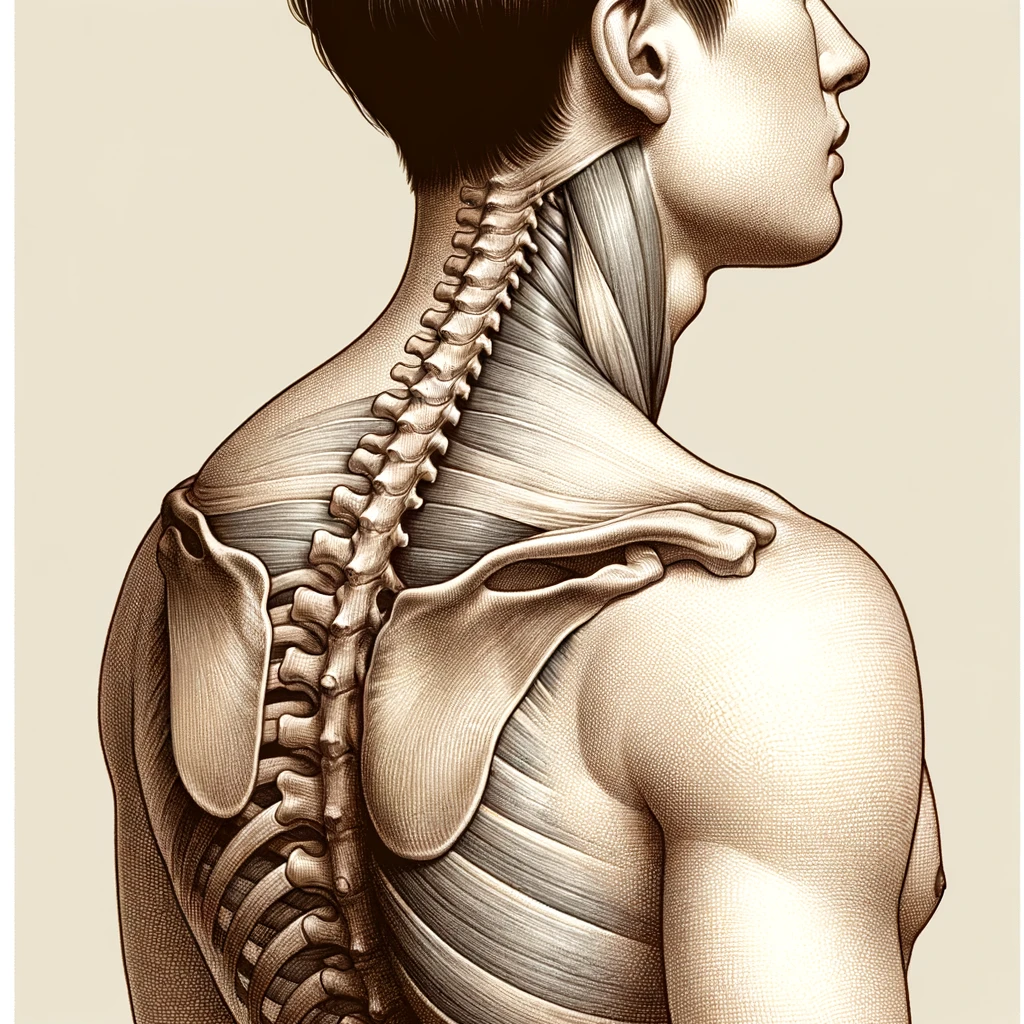Introduction: Understanding Neck Hump – More Than Just a Postural Issue
For many of us, the appearance of a neck hump is not just a cosmetic concern but a distressing physical condition that can significantly impact our quality of life. If you’ve noticed a protrusion at the base of your neck, you’re not alone. Often referred to as a neck hump, this condition can be a source of discomfort, pain, and even embarrassment. It’s a reminder of the hours spent in less-than-ideal postures, in front of screens, or in activities that strain our neck and shoulders.
At Ortho Joint Relief, we understand the complexities and challenges you face with a neck hump. It’s not merely about posture or a cosmetic issue; it’s a health concern that can affect your well-being and confidence. Our expertise in joint health and pain relief has shown us that addressing a neck hump requires a compassionate, informed approach, including neck stretcher devices.
Whether you’re here seeking relief from discomfort, looking to improve your posture, or simply gathering information, we’re here to provide you with understanding, support, and solutions. Let’s explore what a neck hump is, why it happens, and how we can help you on your journey to a more comfortable, confident you.
What Causes Neck Hump? Insights into Thoracic Kyphosis
A neck hump, often clinically referred to as thoracic kyphosis, is a condition where there’s an excessive curvature of the upper back, leading to a noticeable hump at the base of the neck. But what exactly causes this pronounced curve? Understanding the root causes is the first step towards finding relief and improvement.
1. Poor Posture: One of the most common contributors to a neck hump is poor posture, especially with the increasing use of computers and smartphones. Slouching or leaning forward for prolonged periods can strain the neck and shoulder muscles, leading to the development of a hump over time.
2. Ageing: As we age, natural changes in our spine’s structure can lead to an increased curvature. This is often due to degenerative conditions such as osteoporosis, where bones become weaker and more prone to curvature.
3. Genetic Factors: For some, there’s a genetic predisposition to spinal curvatures. If family members have had similar issues, it might be a contributing factor.
4. Lifestyle: A sedentary lifestyle with limited physical activity can weaken the muscles around the spine, contributing to poor posture and the development of a neck hump.
5. Injuries and Health Conditions: Previous injuries to the back or conditions like Scheuermann’s disease can lead to abnormal spine curvature.
Thoracic kyphosis isn’t just a cosmetic issue; it can also lead to discomfort and pain. However, understanding these causes is empowering. With the right approach, including posture correction, exercise, and possibly the use of aids like neck stretchers, managing or even reducing the appearance of a neck hump is achievable. At Ortho Joint Relief, we’re dedicated to offering solutions that address these root causes, providing a pathway to improved posture and relief from discomfort.
The Role of Neck Stretchers in Managing Neck Hump
For those experiencing the discomforts associated with neck hump, also known as thoracic kyphosis, finding effective relief is crucial. Neck stretchers emerge as a potential solution, offering a non-invasive way to address the underlying issues of this condition. Understanding how these devices can aid in managing neck hump is key to improving overall posture and reducing discomfort.
How Neck Stretchers Work
Neck stretchers are designed to apply gentle traction to the neck, which can help separate the vertebrae slightly. This separation aims to alleviate the pressure on discs and nerves, facilitating a reduction in pain and discomfort. The concept behind these devices is rooted in the principle of dynamic traction, which encourages the natural alignment of the neck and spine. Here’s a look at the general benefits and features often found in neck stretchers:
Dynamic Traction allows for a gentle stretching of the neck muscles and separation of the vertebrae, helping to relieve pressure and improve posture. Many neck stretchers come with a heat therapy option, providing targeted warmth to sore muscles. This can enhance blood flow, promote muscle relaxation, and offer relief from tension. Some models offer additional functionalities, such as massage or electrotherapy pads, that can be used on different parts of the body, aiming for a more holistic approach to pain relief.
With a focus on convenience and safety, these devices often feature quiet operation, automatic shutoff mechanisms, and temperature controls to prevent overheating, ensuring a comfortable and secure experience.
Why Consider Using a Neck Stretcher?
In our digital age, prolonged periods spent in front of screens can lead to poor posture and increased strain on the neck and shoulders, contributing to the formation of a neck hump. Neck stretchers provide a practical solution to counteract these effects by supporting the natural curvature of the neck and encouraging proper spinal alignment.
Moreover, the convenience and ease of use of neck stretchers make them an appealing option for those seeking relief in the comfort of their own home. While they are not a one-size-fits-all remedy, incorporating a neck stretcher into a comprehensive approach—including exercise, posture correction, and ergonomic adjustments—can significantly contribute to managing discomfort and improving quality of life.
Neck stretchers represent a promising avenue for individuals looking to address neck hump issues. By offering a combination of dynamic traction, heat therapy, and additional pain-relief features, these devices provide a multi-faceted approach to supporting neck health and improving posture.
Ortho Joint Relief’s neck stretcher is designed to gently relieve neck pain, restore the natural curvature of your neck, and provide true dynamic traction. You also have the convenience of adjusting the heat settings to find your perfect comfort zone or using the external electrode pads for a soothing massage elsewhere on your body. Plus, with silent operation and safety features like auto-shutoff, it’s all about blending efficacy with peace of mind. At Ortho Joint Relief, we also offer US shipping backed by a no-questions-asked money-back guarantee. It’s a risk-free opportunity to see if this solution fits into your life.
Safety and Efficacy: Are Neck Stretchers the Right Choice for You?

When it comes to managing neck hump and seeking relief from associated discomfort, the safety and efficacy of any treatment option are paramount. Neck stretchers, as a non-invasive solution, have garnered attention for their potential benefits. However, it’s essential to consider professional healthcare opinions and understand the appropriateness of these devices for your specific situation.
Safety Considerations of Neck Stretchers
Neck stretchers are designed to be used at home, offering a convenient way to apply gentle traction to the neck. This traction aims to relieve pressure on the vertebrae and improve posture. Most devices are built with user safety in mind, featuring automatic shut-off mechanisms to prevent overuse and controls to regulate intensity levels, such as heat therapy options. Despite these safety features, it’s crucial to use these devices as directed and be mindful of any personal health conditions that might affect suitability.
Chiropractor and Healthcare Professional Opinions
Chiropractors and other healthcare professionals often have mixed opinions on the use of neck stretchers, largely depending on an individual’s specific condition and the device’s quality. Many professionals agree that when used correctly and for appropriate conditions, neck stretchers can contribute positively to a neck pain management regimen. They emphasize the importance of using these devices as part of a comprehensive approach that includes exercises, posture correction, and ergonomic considerations.
Some chiropractors endorse specific types of neck stretchers, especially those that promote natural alignment and support the cervical spine’s curvature. Approval from healthcare professionals adds a layer of trust and credibility to the use of these devices. However, it’s essential to consult with a healthcare provider before starting any new treatment to ensure it aligns with your unique health needs.
Endorsements and Professional Approval
Endorsements from reputable healthcare professionals can significantly enhance trust in neck stretchers. These endorsements often come after thorough evaluation of a device’s design, functionality, and potential health benefits. Products that have received positive feedback from the medical community may offer an added level of assurance for users considering this treatment option.
Determining if Neck Stretchers Are Right for You
While neck stretchers can offer benefits such as reduced pain and improved posture, they’re not suitable for everyone. Factors such as the specific cause of your neck hump, existing health conditions, and personal comfort with the device should be considered. It’s advisable to start with a consultation with a healthcare professional, such as a chiropractor or physical therapist, to assess your condition and discuss whether a neck stretcher could be an effective part of your treatment plan.
Neck stretchers have the potential to be a safe and effective tool for managing neck hump, provided they are used correctly and under the guidance of healthcare professionals. By incorporating professional advice and ensuring any device you consider is endorsed by healthcare professionals, you can make an informed decision on whether neck stretchers are the right choice for you.

How to Use a Neck Stretcher Effectively for Neck Hump Relief
Neck stretchers can be a valuable tool in managing neck hump and alleviating discomfort when used correctly. Here’s a step-by-step guide to ensure you’re getting the most out of your neck stretcher, aimed at promoting ease of use, pain relief, and an enhanced quality of life.
Step 1: Consult with a Healthcare Professional
Before beginning any new treatment regimen, it’s crucial to consult with a healthcare professional. They can provide tailored advice based on your specific condition and confirm whether a neck stretcher is suitable for you.
Step 2: Read the Instructions Carefully
Each neck stretcher comes with its own set of instructions and guidelines. Take the time to read these thoroughly to understand how the device works, any safety precautions, and how to adjust the settings to your needs.
Step 3: Prepare a Comfortable Space
Choose a quiet, comfortable space where you can relax without interruption. Ensure you have a flat surface to lie on, such as a yoga mat on the floor or a firm bed.
Step 4: Position Yourself Correctly
Lay down on your back and gently place your neck onto the neck stretcher, ensuring it’s positioned under the base of your skull. Your head should rest comfortably on the device, with your spine aligned naturally.
Step 5: Start with Gentle Traction
If your neck stretcher has adjustable settings, start with the lowest level of traction and gradually increase it as you become more comfortable with the device. Follow the manufacturer’s recommendations for duration and intensity.
Step 6: Incorporate Heat Therapy If Available
If your device includes a heat therapy feature, use it to enhance muscle relaxation and blood flow. Adjust the temperature to a comfortable level that provides soothing warmth without causing discomfort.
Step 7: Use the Device Regularly
Consistency is key to achieving the best results. Use the neck stretcher regularly, as recommended by the manufacturer or your healthcare provider. However, be mindful not to overdo it; more is not always better.
Step 8: Combine with Other Treatments
For optimal results, integrate the use of the neck stretcher into a broader treatment plan that includes exercises for neck strength and flexibility, posture correction, and ergonomic adjustments in your daily activities.
Step 9: Monitor Your Progress
Keep track of your symptoms and any improvements in pain, posture, and overall comfort. Share these observations with your healthcare provider to adjust your treatment plan as needed.
Step 10: Listen to Your Body
Pay attention to how your body responds to the neck stretcher. If you experience any pain or discomfort, stop using the device and consult with your healthcare professional.
By following these steps, you can maximize the effectiveness of your neck stretcher in managing neck hump and improving your quality of life. Remember, while a neck stretcher can offer significant benefits, it should be used as part of a comprehensive approach to neck health.
Conclusion: Ease Your Way to Relief from Neck Hump Discomfort
So, we’ve taken a good look at neck humps and the silver lining that comes with finding the right help. It’s heartening to learn that solutions like neck stretchers can make a significant difference in managing discomfort and improving your posture. If you’re pondering over whether neck stretchers could be your ticket to relief, it’s definitely worth exploring.
Choosing a neck stretcher means you’re ready to embrace a bit of comfort and innovation rolled into one. These gadgets aren’t just about offering relief; they’re about enhancing your daily life with their dynamic traction, heat therapy, and the added bonus of full-body massage capabilities. Here’s to finding comfort and relief that’s been waiting for you.













